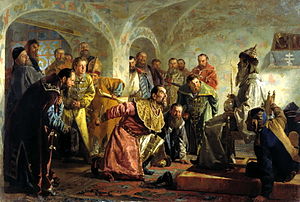Oprichnik
It has been suggested that this article be merged into Oprichnina. (Discuss) Proposed since October 2024. |

Oprichniks (Russian: опри́чники, IPA: [ɐˈprʲitɕnʲɪk], oprichniki, meaning "men of oprichina"; singular: oprichnik) were a corps that served as bodyguards,[1] police, and soldiers[2] established by Tsar Ivan the Terrible. The term derives from the policy of oprichina in Russia carried out by Ivan the Terrible between 1565 and 1572 in an attempt to strengthen his autocracy.
Foundation
[edit]Some scholars believe that Ivan's second wife, the Circassian Maria Temryukovna, first had the idea of forming the organization.[3] This theory comes from Heinrich von Staden, a German oprichnik. Maria Temryukovna's brother also became a leading oprichnik.[citation needed]
Oath
[edit]Upon acceptance, the new Oprichniki were required to swear an oath of allegiance:
I swear to be true to the Lord, Grand Prince, and his realm, to the young Grand Princes, and to the Grand Princess, and not to maintain silence about any evil that I may know or have heard or may hear which is being contemplated against the Tsar, his realms, the young princes or the Tsaritsa. I swear also not to eat or drink with the zemshchina, and not to have anything in common with them. On this I kiss the cross.[4]
Description
[edit]Modern theories suggest that the motivating purpose for the organization and existence of the Oprichniki was to oppress people or groups opposed to the Tsar. Known to ride black horses and led by Ivan himself, the group was known to terrorize civilian populations. Sometimes called the cromeshnina (selected) because they were a hand-picked body,[5] the Oprichniki dressed in black garb, similar to a monastic habit, and carried attached to their saddles a severed dog's head (to sniff out treason and enemies of the Tsar), or an actual wolf's head and a broom (to sweep them away). The wolf's head was also symbolic of the hounds of hell tearing at the heels of the Tsar's enemies.[6] The logistics of acquiring the canine heads was quite gruesome. Due to the lack of taxidermy, the severed and drained heads would only remain frozen for the winter months of the year. To maintain their image, the Oprichnik required a constant supply of fresh heads. Ivan himself carried a fearsome canine head made of iron with jaws that would open and snap shut as his horse galloped.[7]
The Oprichniki were ordered to execute anyone disloyal to Ivan and used various methods of torture to do so, including quartering, death by boiling, impalement, and roasting victims tied to poles over an open fire.[8]
Oprichniki were devout Christians of the Eastern Orthodox Church similarly to the Tsar himself.[2]
When Ivan declared himself the "Hand of God", he selected 300 of the Oprichniki to be his personal "brotherhood" and live in his castle at Aleksandrovskaia Sloboda near Vladimir. At 4 a.m., these select Oprichniki attended a sermon given by Ivan, then performed the day's ritual executions. The Oprichniki sought to lead an externally ascetic lifestyle, like the monks they emulated, but it was punctuated by acts of cruelty and debauchery.[9] In the Novgorod incident, the Oprichniks killed an estimated 1500 "big people" (nobles), although the actual number of victims is unknown.[10]
Appearances in modern media
[edit]
- The Oprichnik is an opera by Pyotr Ilyich Tchaikovsky, based on the drama The Oprichniks (Опричники) (1842) written by Ivan Lazhechnikov.
- Oprichniki Malyuta Skuratov, Alexei Basmanov and his son Fyodor Basmanov are main characters in Ivan the Terrible, a classic historical epic film (released in two parts in 1944 and 1946) directed by Sergei Eisenstein, .
- The song "Dog and Broom" on Arghoslent's Hornets of the Pogrom album focuses specifically on the Oprichniki, and makes reference to their actions during the 1570 Novgorod Massacre.
- Author W. E. B. Griffin's novel Black Ops claims as a plot point that all subsequent Russian secret police agencies such as the SVR are descendants of the Oprichniki.
- The novel Day of the Oprichnik by Vladimir Sorokin imagines the return of the Oprichniki in a futuristic-theocratic Russia.[11]
- The Oprichniki appear in Tsar, a 2009 Russian drama film directed by Pavel Lungin.
- Latter-day Oprichniki appear in Eric Flint's 1636: The Kremlin Games.
- The Oprichniki appear to back up Ivan the Terrible in Deadliest Warrior, against Hernán Cortés and his Conquistadors
See also
[edit]References
[edit]- ^ Shpakovsky, V. (31 January 2006). Armies of Ivan the Terrible. p. 3. ISBN 1-84176-925-8.
- ^ a b Wilde, Robert (2019-05-30). "The Oprichnina of Ivan the Terrible: Part 1, Creation". ThoughtCo. Retrieved 2024-04-17.
- ^ A. P. Pavlov; Maureen Perrie (August 2003). Ivan the Terrible. Pearson Education. pp. 116–7.
- ^ As noticed these individuals did not swear an oath to the Lord Jesus Christ as much as they were swearing to Governers of land. I feel their allegiance to the "Tsar" was not to the true "Cesar" whis is Christ Jesus. de Madariaga, Isabel (2005). "The Setting Up of the Oprichnina". Ivan the Terrible. Yale nota bene (reprint ed.). New Haven: Yale University Press (published 2006). p. 183. ISBN 9780300119732. Retrieved 10 May 2019.
- ^ Shpakovsky, V. (31 January 2006). Armies of Ivan the Terrible. p. 9. ISBN 1-84176-925-8.
- ^ Shpakovsky, V. (31 January 2006). Armies of Ivan the Terrible. p. 10. ISBN 1-84176-925-8.
- ^ Andrew, Christopher (2018). The Secret World- a History of Intelligence. Yale University Press. pp. 141–157. ISBN 978-0-300-23844-0.
- ^ Shpakovsky, V. (31 January 2006). Armies of Ivan the Terrible. p. 10. ISBN 1-84176-925-8.
- ^ Shpakovsky, V. (31 January 2006). Armies of Ivan the Terrible. p. 10. ISBN 1-84176-925-8.
- ^ Ruslan Skrynnikov, Ivan Groznyi (Moscow: AST, 2001); A. A. Zimin, Oprichnina Ivana Groznogo (Moscow: Mysl’, 1964).
- ^ Di Filippo, Paul. ""Day of the Oprichnik": The fascinating world of Soviet science fiction". Salon.com. Retrieved 22 February 2012.
